Shrimp paste
Shrimp paste or prawn sauce is a fermented condiment commonly used in Southeast Asian and Southern Chinese cuisines. It is primarily made from finely crushed shrimp or krill mixed with salt, and then fermented for several weeks. They are either sold in their wet form or are sun-dried and either cut into rectangular blocks or sold in bulk. It is an essential ingredient in many curries, sauces and sambal. Shrimp paste can be found in many meals in Indonesia, Laos, Malaysia, Myanmar, the Philippines, Singapore, Thailand, and Vietnam. It is often an ingredient in dip for fish or vegetables.
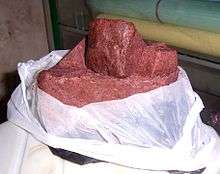 Lengkare shrimp paste from Lombok Island, Indonesia | |
| Alternative names | Prawn sauce |
|---|---|
| Type | Condiment |
| Region or state | Southeast Asia, Southern China |
| Main ingredients | fermented shrimp |
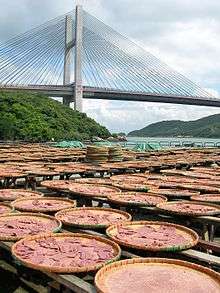
History
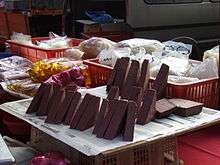
_-_Philippines.jpg)
The tradition to prepare shrimp, fish or seafood through fermentation is widespread in Southeast Asia; it can be found in Maritime Southeast Asia (Indonesia, Malaysia, Brunei and the Philippines) to mainland Southeast Asia (Thailand, Myanmar, Cambodia, Laos, and Vietnam), and southern China to a lesser extent. Fermented fish or seafood is an ancient tradition in Southeast Asia, a similar tradition is demonstrated by Cambodian prahok, which is quite similar to the shrimp paste.
Nevertheless, the origin of shrimp paste seems to point to Maritime Southeast Asia. According to Thai tradition, the origin of kapi (Thai fermented shrimp paste) can be traced to their southern territory. As far back as the eighth century, inhabitants of the coastal cities of Pattani and Nakhon Si Thammarat — located in today's southern Thailand but then ruled by the Malay Kingdom of Srivijaya — used shrimp paste in their cooking.[1] They shared this practice with people from other coastal nations in Southeast Asia, including regions now known as Indonesia, Malaysia, Myanmar, Cambodia and Vietnam. After King Ramkhamhaeng of Sukhothai occupied Pattani in the fourteenth century, shrimp paste (kapi) became available in Thai court, although it was reserved mainly for aristocrats. In 1666, kapi was described by a Persian diplomat named Ibn Muhammad Ibrahim, in derogative manner as "'rotten food unfit for cooking or eating."[1]
Kapi is also described by Simon de La Loubère, a French diplomat appointed by King Louis XIV to the Royal Court of Siam in 1687. In one chapter, "Concerning the Table of the Siamese" he wrote: "Their sauces are plain, a little water with some spices, garlic, chilbols, or some sweet herb, as baulm. They do much esteem a liquid sauce, like mustard, which is only corrupted crayfish, because they are ill salted; they called it Capi."[1]
In 1707, William Dampier described trassi (or terasi, Indonesian shrimp paste) in his book "A New Voyage Round the World"; "A composition of a strong odor, but it became a very tasty meal for the indigenous people." Dampier described it further as a mixture of shrimp and small fish made into a kind of soft pickle with salt and water, and then the dough was packed tightly in a clay jar. The pickling process softens the fish and makes it mushy. Then they poured arrack into the jars to preserve them. "The mushy fish remains was called trassi," Dampier wrote; "The aroma is very strong. However, after adding a little part of it, the dish's flavour became quite savory."[2]
In the 1880s, trassi was described by Anna Forbes, a known racist, during her visit to Ambon. Anna was the wife of British naturalist Henry Ogg Forbes; the couple travelled through the Dutch East Indies in the 1880s. In her journal she describes the culture, customs and tradition of the natives, including their culinary tradition. Because of this foul-smelled ingredient, she accused her cook of trying to poison her and threw away that "horrible rotten package". Later she wrote: "Then, I observed each dish of the native or European, those that I have consumed since my arrival in the East contains this; the essence of that rotten stuff that has been used as a spice."[2]
Varieties
Shrimp paste may vary in appearance from pale liquid sauces to solid chocolate-coloured blocks. Shrimp paste produced in Hong Kong and Vietnam is typically a light pinkish grey; while the type used for Burmese, Lao, Cambodian, Thai and Indonesian cooking is darker brown. In the Philippines, they are commonly bright red or pink, due to the use of angkak (red yeast rice) as a colouring agent.[3][4] While all shrimp paste has a pungent aroma, the scent of higher grade shrimp paste is generally milder. Markets near villages producing shrimp paste are the best places to obtain the highest quality product. Shrimp paste varies between different Asian cultures and can vary in smell, texture and saltiness.[5]
Bagoong alamang
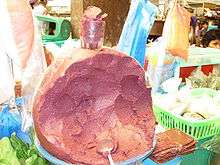
Bagoong alamang (also variously as bagoong, alamang, aramang, uyap, dayok, or ginamos, among others in various Philippine languages) is Filipino for shrimp paste. It is a type of bagoong, which is a class of fermented seafood in Philippine cuisine (including fermented fish, oysters, and clams) which also produces the native fish sauce (patis). It is made from the same Acetes shrimp as in Indonesian and Malaysian variants (known in Filipino/Tagalog as alamang) and is commonly eaten as a topping on green mangoes (also boiled saba bananas or cassava), used as a major cooking ingredient, or sauteed and eaten with white rice. Bagoong paste varies in appearance, flavor, and spiciness depending on the type. Pink and salty bagoong alamang is marketed as "fresh", and is essentially the shrimp-salt mixture left to marinate for a few days. This bagoong is rarely used in this form, save as a topping for unripe mangoes. The paste is customarily sauteed with various condiments, and its flavour can range from salty to spicy-sweet. The colour of the sauce will also vary with the cooking time and the ingredients used in the sauteeing.
Unlike in other parts of Southeast Asia and in Western Visayas,[6] where the shrimp is fermented beyond recognition or ground to a smooth consistency, the shrimp in bagoong alamang (in many parts of the Philippines) is readily identifiable, and the sauce itself has a chunky consistency. A small amount of cooked or sauteed bagoong is served on the side of a popular dish called kare-kare, an oxtail stew made with peanuts. It is also used as the key flavouring ingredient of a sauteed pork dish, known as binagoongan (lit. "that to which bagoong is applied"). The word bagoong, however, is also connoted with the bonnet mouth and anchovy fish version, bagoong terong.
Belacan
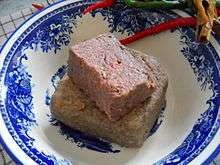
Belacan, a Malay variety of shrimp paste, is prepared from small shrimp from the Acetes species, known as geragau in Malaysia or rebon in Indonesia. In Malaysia, normally the krill are steamed first and after that are mashed into a paste and stored for several months. The fermented shrimp are then prepared, fried and hard-pressed into cakes. William Marsden, an English writer, included the word in his "A Dictionary of the Malayan Language" published in 1812.[7]
Belacan is used as an ingredient in many dishes. A common preparation is sambal belacan, made by mixing toasted belacan with chilli peppers, minced garlic, shallot paste and sugar and then fried. Sometimes it is toasted to bring out the flavour,[8] usually creating a strong, distinctive odour.[9][10]
A version of belacan similar to Filipino "fresh" bagoong alamang shrimp paste (which is fermented for a shorter period) is known as cincalok.
In Sri Lanka, belacan is a key ingredient used to make Lamprais.[11]
Galmbo
Galmbo are dried baby shrimps which are ground with dried red chillies, spices and palm vinegar to make a spice paste used in the sour, sweet and spicy sauce known as balchao in Goa, India. It was brought to Goa by the Portuguese and originated in Macao. It is more like a pickle and is used as a side condiment in small quantities.
Harm ha (xiā jiàng)
[hànzì = 鹹蝦 Cantonese: haam4 haa1 / Mandarin: xián xiā / 鹹 = salted 蝦 = shrimp] In English, it is also found spelled "ham ha" and "hom ha." It is a finely ground shrimp paste popular in southeastern Chinese cooking, and a staple seasoning in many places Cantonese people settled. It is lighter in colour compared to shrimp pastes made farther south. It is considered indispensable in many pork, seafood, and vegetable stir fry dishes. The smell and flavor are very strong. A pearl-sized ball of harm ha is enough to season a stir fry for two people. The shrimp paste industry has historically been important in the Hong Kong region, and Hong Kong factories continue to ship harm ha to communities around the world.
Harm ha also may be found labelled 蝦酱 [Cantonese: haa1 zoeng3 / Mandarin: xiā jiàng (Mandarin) 蝦 = shrimp 酱 = sauce/paste] [12]
Kapi
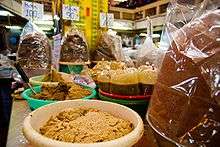
In Thailand shrimp paste (kapi, กะปิ, IPA: [kapìʔ]) is an essential ingredient in many types of nam phrik, spicy dips or sauces, and in all Thai curry pastes, such as the paste used in kaeng som. Very popular in Thailand is nam phrik kapi, a spicy condiment made with fresh shrimp paste and most often eaten together with fried pla thu (short mackerel) and fried, steamed or raw vegetables. In Southern Thailand there are three types of shrimp paste: one made only from shrimp, one containing a mixture of shrimp and fish ingredients, and another paste that is sweet.[13] 'Nam prik meng daa' is available in Hat Yai and Satul markets. Meng daa is a night flying bug and its body fluids are pressed and mixed with 'kapi', quite sweet. 'nam prik makaam' is 'kapi' mixed with tamarind, more sour.
Another common Thai food product is nam kung, which is confusingly also commonly translated as "shrimp paste". Nam kung is orange, oily, and more liquid while kapi is grey, light purple or even black, and much more solid and crumbly. Nam kung is actually the fat from inside the head of the shrimp, from the organ that plays the role of the liver and pancreas, making it somewhat like a shrimp pâté or foie gras. The term "shrimp tomalley" may also be used for nam kung although "tomalley" by default is generally assumed to be harvested from lobster or crab, and may also be used in English translations of the culinary extremely different Japanese food product kanimiso.
Mắm tôm
In Vietnam shrimp paste (mắm tôm, IPA: [mam˧ˀ˦ tom˧]) are of two varieties: a thickened paste or a more liquefied sauce. To prepare for serving it is usually mixed with sugar, lime juice, kumquat and chili when used as a dipping sauce. Vietnamese people often use mắm tôm as a dipping sauce for boiled meat, fried tofu, fried fish or for seasoning some soup dishes.[14]
Ngapi yay
A watery dip or condiment that is very popular in Myanmar, especially the Burmese and Karen ethnic groups. The ngapi (either fish or shrimp, but mostly whole fish ngapi is used) is boiled with onions, tomato, garlic, pepper and other spices. The result is a greenish-grey broth-like sauce, which makes its way to every Burmese dining table. Fresh, raw or blanched vegetables and fruits (such as mint, cabbage, tomatoes, green mangoes, green apples, olives, chilli, onions and garlic) are dipped into the ngapi yay and eaten. Sometimes, in less affluent families, ngapi yay forms the main dish, and also the main source of protein.
Petis udang or hae ko
Petis udang is black coloured shrimp paste in Indonesian and Malay. It is called Hae ko in the Hokkien dialect, which means prawn paste. Petis udang is a version of shrimp/prawn paste used in Indonesia, Malaysia and Singapore. In Indonesia it is particularly popular in East Java. This thick black paste has a molasses like consistency instead of the hard brick like appearance of belacan. It also tastes sweeter because of the added sugar. Petis is produced by boiling down the slurry of leftovers from shrimp processing. Molasses is generally added to provide a sweetish flavour to the petis. It is used to flavour common local street foods like popiah spring rolls, Asam laksa, chee cheong fan rice rolls and rojak salads,[15] such as rujak cingur and rujak petis. In Indonesia, major producer of petis are home industries in Sidoarjo, Pasuruan and Gresik area in East Java.
Sidol
In the Chittagong Hill Tracts, Bangladesh, shrimp paste is called sidol or nappi by the indigenous Jumma people. They use it to make vegetable food, such as bamboo shoots curry. This bamboo shoot curry is a traditional food of the indigenous Jumma people. They eat it in this way. First bamboo shoots are collected from the bamboo forest, then defoliated and boiled in water. Then boiling water is mixed with the shrimp paste. Some chili, garlic paste, salt, and flour are added to the shrimp paste mixed with water. The mixture is heated and, after a few minutes, put on the boiled bamboo shoots on the mixture while still heating. After some minutes, the food is ready to serve.
Terasi
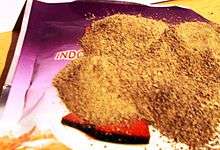
Terasi (trassi in Dutch), an Indonesian (especially Javanese) variant of dried shrimp paste, is usually purchased in dark blocks, but is also sometimes sold ground as granulated coarse powder. The colour and aroma of terasi varies depending on which village produced it. The colour ranges from a soft purple-reddish hue to darkish brown. In Cirebon, a coastal city in West Java, terasi is made from tiny shrimp (Acetes) called rebon, the origin of the city's name. Another kind is petis made from shrimp or tuna mixed with palm sugar. In Sidoarjo, East Java, terasi is made from the mixture of ingredients such as fish, small shrimp (udang), and vegetables. Terasi is an important ingredient in sambal Terasi, also many other Indonesian cuisine, such as sayur asam (fresh sour vegetable soup), lotek (also called gado-gado, Indonesian style salad in peanut sauce), karedok (similar to lotek, but the vegetables are served raw), and rujak (Indonesian style hot and spicy fruit salad).
On the island of Lombok, Indonesia, a more savoury and sweet shrimp paste called lengkare is made.
Industry
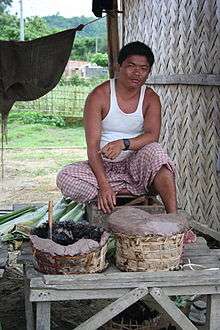
Shrimp paste continues to be made by fishing families in coastal villages. They sell it to vendors, middlemen or distributors who package it for resale to consumers. Shrimp paste is often known for the region it comes from since production techniques and quality vary from village to village. Some coastal regions in Indonesia such as Bagansiapiapi in Riau, Indramayu and Cirebon in West Java, and Sidoarjo in East Java; as well as villages such as Pulau Betong in Malaysia or Ma Wan island in Hong Kong and in Lingayen Gulf, Pangasinan in the Philippines are well known for producing very fine quality shrimp paste.
Preparation
Preparation techniques can vary greatly; however, the following procedure is most common in China, and much of Southeast Asia.
After being caught, small shrimp are unloaded, rinsed and drained before being dried. Drying can be done on plastic mats on the ground in the sun, on metal beds on low stilts, or using other methods. After several days, the shrimp-salt mixture will darken and turn into a thick pulp. If the shrimp used to produce the paste were small, it is ready to be served as soon as the individual shrimp have broken-down beyond recognition. If the shrimp are larger, fermentation will take longer and the pulp will be ground to provide a smoother consistency. The fermentation/grinding process is usually repeated several times until the paste fully matures. The paste is then dried and cut into bricks by the villagers to be sold. Dried shrimp paste does not require refrigeration.[16][17][18]
Availability
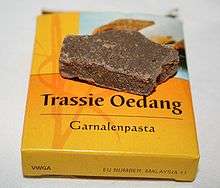
Shrimp paste can be found in nations outside Southeast Asia in markets catering to Asian customers. In the Netherlands, Indonesian type of shrimp paste can be found in supermarkets selling Asian foodstuff such as Trassie Oedang from the Conimex brand. In the United States brands of Thai shrimp paste such as Pantainorasingh and Tra Chang can be found. Shrimp pastes from other countries are also available in Asian supermarkets and through mail order. It is also readily available in Suriname due to the high concentration of Javanese inhabitants. In Australia shrimp paste can be found in most suburbs where Southeast Asian people reside.[19][20]
See also
- Bagoong monamon – Philppine food ingredient made by fermenting salted anchovies
- Budu – Fish sauce originating from east coast of Peninsular Malaysia
- Conpoy – Cantonese dried scallop
- Dried shrimp
- Fish paste – Paste made of fish meat
- Fish sauce – A condiment made from fish coated in salt and fermented
- Garum – Fermented fish sauce used as a condiment in ancient Rome
- Kangkung belacan
- Liquamen
- Ma Wan – Island in Hong Kong island (Tin Liu village) for one the Hong Kong site producing the paste
- Padaek – A traditional Lao condiment made from pickled or fermented fish that has been cured
- Prahok – A crushed, salted and fermented fish paste used in Cambodian cuisine
- Saeu-jeot – Salted and fermented small shrimp in Korean cuisine
- Sambal – Indonesian spicy sauce
- List of Thai ingredients – Wikipedia list article
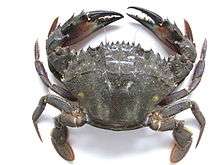

References
- Su-Mei Yu. "A Lamentation for Shrimp Paste". Gastronomica, the Journal of Critical Food Studies.
- Mahandis Yoanata Thamrin. "Terasi dalam Catatan Perjalanan Pelancong Terlawas". National Geographic Indonesia (in Indonesian). Retrieved 24 September 2015.
- Visessanguan, Wonnop; Chaikaew, Siriporn (2014). "Shellfish Products". In Sarkar, Prabir K.; Nout, M.J. Robert (eds.). Handbook of Indigenous Foods Involving Alkaline Fermentation. CRC Press. pp. 212–213. ISBN 9781466565302.
- Redhead, J.F. (1990). Use of Tropical Foods: Animal products. FAO Food and Nutrition Paper. Food & Agriculture Organization of the United Nations. p. 35. ISBN 9789251028780.
- "TERASI – (Dried Shrimp Paste)". Archived from the original on 7 July 2011. Retrieved 11 July 2011.
- In Western Visayas, shrimp paste or "ginamos" is prepared in a very similar way as in other Southeast Asian nations. In Iloilo, especially in Banate (famous for this delicacy), the minute shrimps or "hipon" are salted, dried under the sun, and then grounded.
- Marsden, William (1 January 1812). A Dictionary of the Malayan Language. Cox and Baylis – via Internet Archive.
- "3 Easy Ways to Roast Belacan (Dried Shrimp Paste)".
- Pierson, Stephanie (4 October 2011). "The Brisket Book: A Love Story with Recipes". Andrews McMeel Publishing – via Google Books.
- Eats, Serious. "An Intro to Malaysian Food: The Ingredients".
- https://explorepartsunknown.com/sri-lanka/history-baked-in-a-banana-leaf/
- "Shrimp Sauce / Paste". Retrieved 11 July 2011.
- อาหารการกินแห่งลุ่มทะเลสาบ.สงขลา: เครือข่ายสตรรอบทะเลสาบ. 2551. หน้า 34–35
- Mộc Miên (21 March 2017). "Mắm tôm – đặc sản dậy mùi vùng duyên hải xứ Thanh" (in Vietnamese). Retrieved 6 May 2018.
- "Food & Recipes – Asia Society".
- "Shrimp Paste – Gkabi". Retrieved 11 July 2011.
- "Dried shrimp paste". Retrieved 11 July 2011.
- "How Shrimp Paste is Made". Retrieved 11 July 2011.
- "Shrimp Paste". Retrieved 11 July 2011.
- "Ethnic Cuisine: Indonesia". Archived from the original on 22 January 2009. Retrieved 11 July 2011.
External links
| Wikimedia Commons has media related to Shrimp paste. |
- Thai Shrimp Paste Kasma Loha-unchit in Dancing Shrimp: Favorite Thai Recipes for Seafood.

